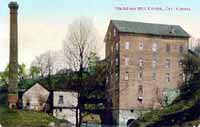
 | Blackfriars Mill, about 1910, shortly before it was abandoned and demolished. The mill was located in what is now Harris Park. |
It is possible that, even without the relocation of the district government in 1826, a settlement of some size would have developed at the Forks. Two early roads, Commissioners and Wharncliffe, passed near by, and several good mill sites could be found there. Mills were a necessity in the pioneer era, providing farmers with a place to sell their wheat, and the community with a supply of flour.
Two of London's first mills appeared on either side of Blackfriars Bridge, the first version of which may have been built as early as the fall of 1826. Dennis O'Brien, one of London's first merchants, built a flour mill south of Blackfriars Bridge in the early 1830s and another mill, Water's, went up just north of the bridge, where Carling's Creek now enters the north Branch of the Thames. Both were water powered originally. In 1855, the Hunt mill was constructed next to Labatt's brewery and powered by the south branch. Today, a dam is still located near the spot where Hunt's mill dam would have been.
By 1860, the Blackfriars mill was grinding 480 bushels a day, and the Hunt mill was producing 30,000 barrels of flour, most of which was shipped to Montreal for export. The North Branch mills, across from what is now Gibbons Park, were grinding 25,000 bushels of grain a year. These mills, still water powered, would replace their huge circular grinding stones in the 1880s with rollers, and would, by then, be steam driven.

|
|